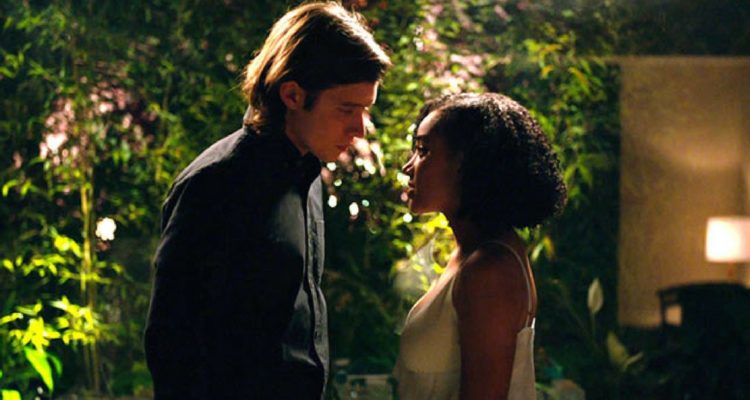If you swoon for the longing of forbidden love and if you’re a sucker for a mystery unraveling, you need to read Nicola Yoon’s young adult novel Everything, Everything (2015). This fast-paced read is about a girl in a tower, cut off from the world by a disease called Severe Combined Immunodeficiency (SCID). Maddy’s allergic to everything and anything can kill her. So she’s stayed indoors, in her house, her whole life—since she was three months old.
Only now she’s eighteen. What she knows of the outside world comes through her online courses, connection to the Internet, and from her mother and nurse Carla. She has no other human interaction. She spends time peering from the windows of her home, content to observe only what’s within eyesight. Until one day, a new family moves in next door. And with them comes a very cute teenaged boy named Olly.
Olly’s bedroom is across a narrow yard from her own. They immediately find each other attractive, but alas, no one is allowed to visit, and Maddy can’t risk leaving the house. Her over-protective mom wouldn’t have it, plus she could, you know, die. But the heart wants what it wants, so soon the two begin communicating by text and IM. As they get to know each other and their attraction builds, Maddy wants more. Her castle is confining, her isolation unbearable.
Finally, while her mom is at work, Carla allows Olly to visit. But they have to promise not to touch. To stay away from each other. In the book, their yearning is palpable. The story of Maddy and Olly falling in love is as delightful as it is heartbreaking. Talk about star-crossed lovers. As they become increasingly anxious to see each other, Maddy starts to wonder just how sick she really is. She hadn’t been outdoors or away from the air filtration system for eighteen years. Is her disease still so dire?
Maddy feels fine for the most part. Maybe she should test the waters—see if life lived from afar is still necessary. This is where the mystery part kicks in, and I’ll stop here so I don’t spoil the story. Suffice it to say I read this fast-paced book in one afternoon, and it was an afternoon well spent. Would I be able to say the same of the film, which just hit theaters on May 19th?
How Does the Movie Compare?
The movie version of Everything, Everything is a creatively produced film with fine acting, decent pacing, spectacular sets, and one flaw: Maddy and Olly don’t have the sizzling chemistry that they had in the book. This is not to say that the actors aren’t great—in particular I lingered on Amandla Stenberg ’s every sweet expression—but I never felt the aching, desperate longing between the characters that I did in the book. That aside, I nonetheless rooted for the couple and enjoyed watching their romance bud.
The most noteworthy difference between reading Everything, Everything and seeing it on screen was that I noticed race in the movie. We know in the book that Maddy’s half Japanese and half African-American and Olly’s white, but it’s basically a moot point. Maddy’s existence in a bubble removes her from any lived experience of race. Because she’s never had anyone other than her mother and nurse (and now Olly) respond to her as a corporeal being—her self inextricably connected to her body—in the book she’s essentially un-racial.
When Olly and Maddy were on screen, however, I was forced to acknowledge their races, which made me realize how few biracial romances there are in film. In written form, Maddy and Olly are just people. In living color they are filtered through our racialized lens. Should it matter? It doesn’t to the characters, but it might to a lot of little girls who want to see someone who looks like they do fall in love too.
The bottom line:
It’s a pretty movie with lush set pieces and a worthwhile tale. There are flaws, and the ending ramps up the stakes without fleshing out the results. However, it’s worth an hour and a half of your time if you’re a sucker for romance.
Everything Everything Book Club Questions
If you’re in a book club and you want to do something different, you should spend an evening comparing the novel to the movie. You could read it on your own and do a trip to the cinema, followed by book club. Just a suggestion! Here are five book club questions to get the conversation started. Happy discussing!
- Maddy is a book worm, and Olly’s into math. How are these interests a response to their individual characters or life experience?
- Maddy hasn’t left her house in 18 years nor does she have in-person contact with her peers. How has she stayed sane this long? Was Olly the only one who could make her want more or was it inevitable that she’d demand a change?
- Maddy is very creative, and the book includes her illustrations. How did the movie showcase Maddy’s creativity? Did it help with the scenes when she and Olly couldn’t be together?
- Because Maddy is supposedly very sick, almost all of her interactions with the world occur through the written word or her illustrations. A majority of her social interactions are divorced from her body. How does that change the way she interacts with Olly, compared to someone who’s always lived on the “outside” and been judged—for good or bad—on the way they look?
- Let’s talk about the parents in this book. Olly’s father is abusive and Maddy’s mom is…well, you know how she is. What did you think about the ending? Is any of it justifiable? Should they reconcile? Was it fleshed out enough? What did you think of the parental relationships?
Comment below: How do you think you’d cope if you couldn’t ever leave your house?


